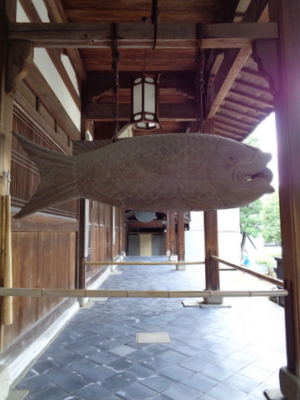Difference between revisions of "Mokugyo"
From SamuraiWiki
Jump to navigationJump to search| Line 1: | Line 1: | ||
| − | [[File:Mokugyo.jpg|right|thumb|300px|A ''mokugyo'' | + | [[File:Mokugyo-manpukuji.jpg|right|thumb|300px|A ''mokugyo'' at [[Manpuku-ji]].]] |
*''Japanese'': 木魚 ''(mokugyo)'' | *''Japanese'': 木魚 ''(mokugyo)'' | ||
Latest revision as of 19:39, 2 June 2020

A mokugyo at Manpuku-ji.
- Japanese: 木魚 (mokugyo)
A mokugyo (lit. wooden fish) is a style of slit gong used in Buddhist and Daoist ceremonies, in which it is struck to accompany chanting, e.g. of sutras. The gong is typically decorated with the form of a fish holding a ball or jewel in its mouth, symbolic of the cosmos. The fish's wide-open eyes are representative of eternally wakeful attention and vigilance in devotion.
Mokugyo exist in many sizes and forms, including small handheld ones, as well as large ones hung from the rafters at temples.
References
- Gallery labels, "Buddhism," Musical Instruments gallery, Metropolitan Museum, Sept 2013.